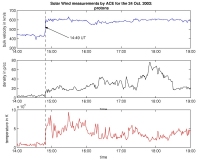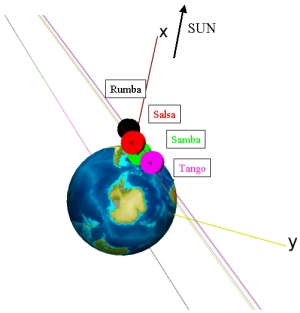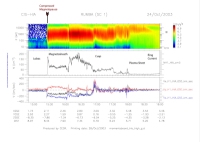Solar Storms October/November 2003
The four Cluster spacecraft were in the southern magnetospheric lobe, inbound towards their perigee. Note that the Sun, ACE, Cluster and the Earth were almost aligned when the CME was ejected from the Sun. Cluster was situated close to the inner magnetosphere (near to the ring current region) when it detected the effects of the solar wind pressure on the magnetosphere: The sudden increase of the solar wind pressure registered by ACE arrived at the Earth's magnetosphere about 40 minutes later. It provoked a huge compression of the dayside magnetosphere. The Cluster spacecraft detected this compression by getting suddenly out of the southern magnetospheric lobe into the Magnetosheath. They thus detected the Magnetopause, moving earthward, at about 15:25 UT. They remained into the Magnetosheath until about 17:00 UT, when they were only at a 6.8 RE (Earth radii) distance from the Earth. The transition between the lobes and the Magnetosheath was characterised by an important ion density increase (from close to 0 in the lobe to more than 160 particles cm-3 in the Magnetosheath) as well as a very clear signature in the velocity components, as measured by the CIS experiment onboard Cluster (P.I: Henri Rème).
This is a very unusual position for the Magnetopause, which on the average is standing ahead of the Earth at about 10 to 11 RE. Such compressions can have dramatic space weather effects, particularly to geostationnary satellites which are orbiting the Earth at a distance of about 6.6 RE. Further analysis of the four spacecraft data will tell us at what speed the magnetopause moved which will give information on the strength of the CME.
Contact points: Iannis Dandouras (Iannis.Dandouras cesr.fr), Claire Vallat (Claire.Vallat
cesr.fr), Claire Vallat (Claire.Vallat cesr.fr) and Philippe Escoubet (philippe.escoubet
cesr.fr) and Philippe Escoubet (philippe.escoubet esa.int).
esa.int).



